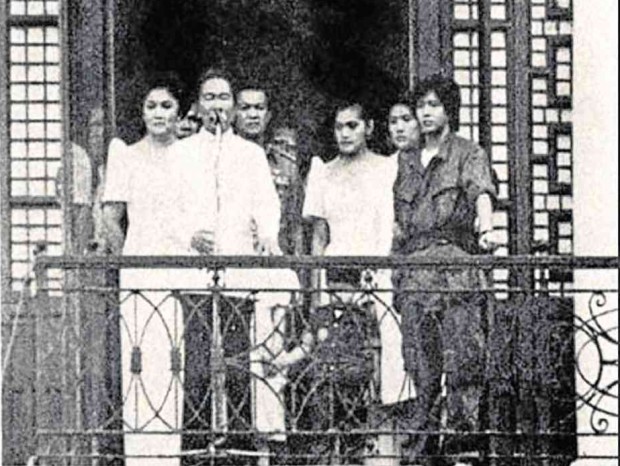Timeline of Marcos family’s political comeback in Philippines

LAST HURRAH Dictator Ferdinand Marcos, flanked by wife Imelda and children Imee, Irene and Bongbong,
addresses his supporters from a balcony in Malacañang on Feb. 25, 1986, after taking his oath of office. MR & MS PHOTO
The family of late Philippine dictator Ferdinand Marcos has enjoyed a remarkable political comeback since the “People Power” revolution ended his rule in 1986.
That revival received another big boost on Tuesday after the Supreme Court granted his family’s long-running request for the former President to be buried at the national heroes’ cemetery in Manila.
The following is a timeline of key dates in the family’s political resurrection.
1991: The return
Then-President Corazon Aquino, Marcos’ political rival, allows former first lady Imelda Marcos to return to the Philippines from exile in the United States to face charges of graft and tax evasion. Taking advantage of a corrupt and often dysfunctional judicial system, she will go on to defeat or evade all charges against her.
Article continues after this advertisement1992: ‘Great again’
Article continues after this advertisementImelda Marcos runs for president calling for the nation to be “great again.” She finishes in fifth place in an election won by retired general Fidel Ramos. But the dictator’s son and namesake Ferdinand Marcos Jnr, known as Bongbong, wins a congressional seat representing Ilocos Norte, the dictator’s home province and family’s enduring political stronghold.
1993: Body flown home
Ramos lifts the ban on the return of the body of the dictator, who died in exile in Hawaii in 1989. But, like Aquino, Ramos objects to giving Marcos a state burial in the capital Manila and the remains are flown to Ilocos Norte.
1995: ‘Congresswoman’ Imelda
Imelda Marcos becomes a congresswoman after a landslide victory in her home province of Leyte in the central Philippines. A remarkably few political clans dominate Philippine politics and her relatives had long held power there, so the win is not surprising. Also, the Marcoses treated Leyte and Ilocos Norte better than other provinces during the dictatorship.
1998: Cementing control
Imelda Marcos again runs for president. She later withdraws from the race after lagging behind in the polls but her children cement control over Ilocos Norte. Bongbong is elected provincial governor while elder sister Imee takes over as a congresswoman representing Ilocos Norte.
2010: Highest post
Bongbong Marcos is elected senator, winning the highest national post for the family since returning from exile. He campaigns on a platform as a progressive politician with a strong track record in Ilocos Norte, while denying his parents ever committed crimes during the dictatorship. That message is well received by a young generation of voters with no experience of his father’s authoritarian rule. Imee is elected Ilocos Norte governor while Imelda gets a fresh taste of power as congresswoman of her husband’s province.
2013: Re-elections
Imelda and Imee Marcos are re-elected for another three years.
2016: Bitter-sweet elections
Bongbong Marcos runs for vice president, narrowly losing the race and frustrating his mother’s wish for the family to reclaim the presidential palace. However, Imelda and Imee win a third term as Ilocos Norte congresswoman and governor, and Bongbong continues to maintain a high national profile. Meanwhile, longtime family ally and provincial mayor Rodrigo Duterte wins the presidency. He thanks the Marcoses for their financial support during his campaign and announces he will allow the late dictator to be buried at the national heroes’ cemetery in Manila./rga
RELATED VIDEO